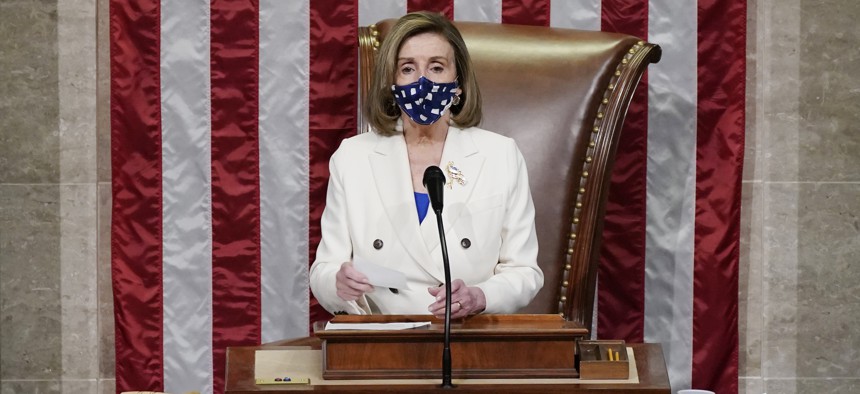Central IT Modernization Fund Gets $1B in COVID Stimulus

Speaker of the House Nancy Pelosi, D-Calif., leads the vote to approve a landmark $1.9 trillion COVID-19 relief bill, at the Capitol in Washington, Wednesday, March 10, 2021. J. Scott Applewhite/AP
The major infusion of cash will mean more modernization projects, which might require a new funding model.
Congress has decided to get serious about funding federal IT upgrades through the Technology Modernization Fund, with a $1 billion infusion of cash for the central fund included in the American Rescue Plan Act passed Wednesday.
The TMF—established as part of the Modernizing Government Technology Act of 2017—was designed to be a self-sustaining centralized pool from which agencies can apply for loans for technology upgrades. Prior to Wednesday’s funding bill, Congress had only approved a maximum of $175 million for the fund: After an initial outlay of $100 million, lawmakers declined to add more than $25 million per budget cycle.
That money has been used to fund 10 projects over three years, some of which have already finished repaying the loan.
While the total isn’t the $9 billion the Biden administration asked for in the American Rescue Plan, or even the $3.1 billion originally proposed by then-President Obama, the $1 billion influx is a turning point for the fund.
The funding boost, as well as other federal tech funding wrapped into the American Rescue Plan Act, passed the House Wednesday by a vote of 220-211 and goes to the president’s desk for signing.
Rep. Gerry Connolly, D-Va., a coauthor of the MGT Act, noted the connection between giving Americans relief during the pandemic and ensuring the government’s IT systems are equipped to deliver that relief.
“Despite urgent congressional action to provide unprecedented levels of economic assistance, those in need have had their misery exacerbated by a broken IT infrastructure that has prevented them from receiving timely support,” Connolly said Wednesday after the bill passed. “This $1 billion investment will enable federal agencies to better respond to the coronavirus pandemic and future national emergencies as well as meet the urgent economic needs of American families.”
Along with the myriad of projects that can be funded with this money, the large cash infusion will also help meet the overhead costs of the program management office, based out of the General Services Administration.
The PMO is maintained through administrative fees assessed on agencies as part of the payback model. With a cap at only $150 million, the office was never going to be able to charge enough in fees to remain solvent, according to the Government Accountability Office.
Having more than $1 billion in the fund should be enough of a base, once that money is out the door and coming back in the form of structured payments. However, part of the American Rescue Plan and Biden’s push for more TMF funding includes ditching some repayment requirements.
The stimulus bill passed Wednesday gives no direction on how the money should be used; it merely allocates “$1,000,000,000 to remain available until September 30,2025, to carry out the purposes of the Technology Modernization Fund.”
Matthew Cornelius, executive director of the Alliance for Digital Innovation and former senior technology and cybersecurity advisor at OMB during the Trump administration, said the Biden administration will need to make changes to TMF, and has the authority to do so.
“The MGT Act gave the OMB director the authority to delay or suspend repayment for TMF funds and they should use that authority to ensure OMB and GSA can quickly and effectively spend money on high priority IT challenges that continue to persist a year into the pandemic,” he told Nextgov. “Jettisoning repayment doesn’t relax oversight—any investments will still have to show progress to the board—but it will allow the money to be put to immediate and substantive use, which is why Congress funded the TMF.”
Cornelius also suggested changes to the way the TMF Board—the body that decides which projects to fund—gets money out the door.
“A new administration needs a new approach to the TMF because the current model appears to not be generating any demand,” he said. “OMB and GSA should flip the current process of only relying on agency submissions and, instead, use TMF funds to invest in shared services or multi-agency projects that are simply harder to get funded under normal budget and appropriations processes.”






